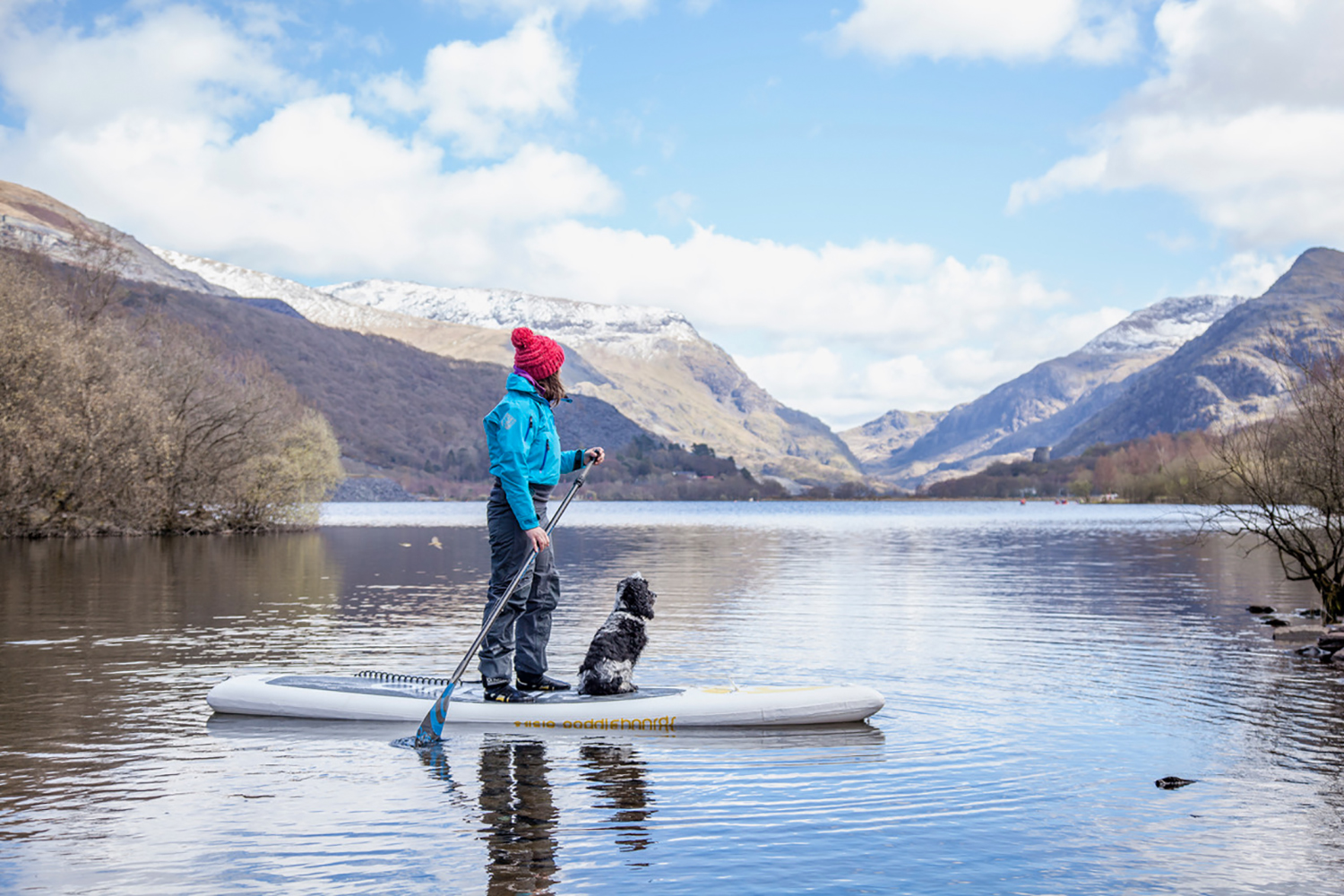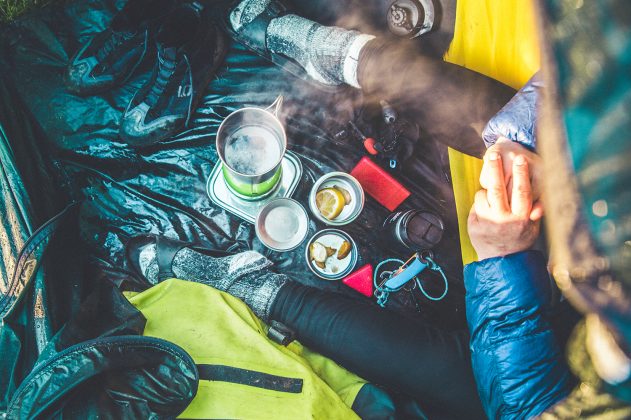GET PSYCHED #13 –
PREPARING FOR WINTER.
With – Sian Sykes
Photos – Ian Finch
The prospect of dark mornings, dragging yourself back to the gym and laying up your paddling kit is not a cheery one. But why hibernate for the winter when with a bit of preparation, you can still go out paddle boarding?
Paddling in winter has its own set of challenges and rewards. Even a trip to your local lake that during summer was packed with kids on inflatable flamingos can feel like a mini-expedition when the temperatures are in the minus and the sun has barely risen above the land. The sense of achievement when you make your plan, carry out your adventure, and then debrief with your buddies in a warm inn with the flames of the fireside flickering on your faces is something else. The water always demands respect, more so when it’s cold, dark, and there are less eyes on it, so here are my considerations for paddling right through the cold months.
First, check the conditions!
Always be mindful about the forecast as it is a prediction and subject to change, and changes in weather factors in winter can be very volatile. We must also think about the wind chill factor which isn’t always forecasted, and also have a better understanding of the implications of us falling into the water as we are now entering cold water shock territory. Which leads us nicely on to…
Clothing and insulation
Obviously there are many options available to paddlers in this day and age as we have adapted our insulation solutions from surfing and kayak backgrounds. My big thing is to start at the top and pay attention to protecting your ears – you need to be mindful of the creep of surfer’s ear during winter. Personally I wear a 5mm with built in hood if I’m sup surfing and immersion is mandatory. Wetsuits have obvious benefits for keeping you warm in water, they’re readily available, relatively low cost and low maintenance. But on a longer journey you might find they start to chafe, thick winter ones do compromise a little on mobility, and once you’re stopped and aren’t generating body heat they can cool off quickly.

A drysuit is a potentially a warmer option than a wetsuit as you can layer up underneath it with thermals to suit the demands of your environment. It keeps you dry if you fall in, is a great wind barrier and some of them are breathable which means that perspiration can’t build up which would chill you down when you stop moving. Drysuits have the ability to keep the paddler warm and dry regardless of how cold the water or windchill is, and they impose little if any hindrance on mobility though ‘fully loaded’ suits can be bulky.
Many drysuits have relief zippers for men, and some ‘Gucci’ versions have relief zippers for women…very useful if you don’t want to have to half-undress when nature calls. Drysuits also often come in bright colours, designed to keep you visible at sea.
The key thing when with layering with thermals is that we don’t use cotton as when we perspire, cotton will hold on to that moisture and won’t wick it away. I like Merino wool as it keeps you nice and toasty and you don’t stink, even if you wear it twenty days in a row – unlike synthetics! It’s useful to have a micro fleece baselayer over the thermals if it is a colder day, but consider your personal requirements as not all of us will want to use the same amount of layers. And the big tip is layering up – it’s always a winner –you can easily unpeel or add layers according to the fluctuations in temperature and your work rate.
Another solution is to use a split suit with separate jacket and trousers which brings all sorts of conveniences; the trousers come up high and have a salopette type fitting so that even in an accidental immersion, if they are cinched up tight you can prevent water ingress. I can also combo the jacket with a wetsuit if I need the extra thermal protection during a quick session and once again the hood is useful for protecting your ears.
Some drysuits come fitted with integral socks. These are great for keeping feet warm but require caution when changing as small stones and rough surfaces can puncture tiny holes in them which are undetectable until you are standing in water…
“Hot drinks are good for morale, and if things have changed and you need to stop and make a new plan it gives you a chance to slow down and think about the situation.”
Protect your extremities
Look after you head, hands and feet! We lose a lot of body heat from our head due to its large surface area, and our hands and feet are packed with extensive networks of blood vessels which mean they need to stay warm to function properly.
If it’s chucking it down rain, I wear a baseball hat with a hood up as the peak helps keep rain off the face, and of course a beanie is a good way to protect your ears. Suitable gloves are essential as things get really difficult when we lose the fine control of our digits. For those that struggle with poor circulation or conditions such as Raynauds, being on top of the situation before problems set in is critical. You can now get neoprene paddlers’ mitts that have a hole in the palm which allows you to still feel the paddle and easily access your fingers to adjust fin bolts, check a map etc…while still giving excellent protection against the elements.
Normal neoprene gloves are OK for a couple of hours but sometimes mean that you can’t feel the paddle and they can cause forerarm pump if you are working hard. If you’re paddling on canals and don’t expect immersion or to be paddling with much effort, ski gloves are a cheap and available alternative.
For the feet, an obvious choice is the neoprene surfing boot, but the fit needs to be right. If they are too tight will squeeze against your toes and impede circulation making your toes go numb. Too loose of course doesn’t work either.
Vivo barefoot running shoes are useful. They have good grip but aren’t too bulky, and the Swim Run type have a draw-string system to tie them up rather than laces. With a drysuit and their built in socks and a pair of thermal socks underneath, neoprene boots (the required size up) add a lot to the surface area of your feet which can make it hard to feel the board. The Vivo ones are a good solution to this as they are relatively low volume and more comfortable.
Provisions and support kit
So, we’re personally protected, but what else are we going to take out on the water with us? As ever, we must be mindful of the change in temperature. Definitely take a flask with a hot drink. Hot drinks are good for morale, and if things have changed and you need to stop and make a new plan it gives you a chance to slow down and think about the situation. Hot drinks can be shared among friends and in reusable cups will also warm hands – a big psychological booster. I would say that strong caffeine isn’t advisable due to the diuretic effect which can cause dehydration which in turn lowers body temperature.
Bring some snacks, as you may be out there longer than you expect. Be aware of the sugar rush which gives you a quick hit and then the come down, go for stuff with a slower energy release.
Pack a drybag with some extra clothing for yourself (extra hat!) I’m a really big fan of the reusable hot water pouches from Lifesystems. Hit them to break them and they start releasing heat, lovely. Once finished, to reactivate them you just drop them in a pan of hot water to recharge.
It’s good to pack massive oversized storm jacket, Peak do a good one that’s like wearing a storm shelter (it fits over your buoyancy aid) which is very useful if you are stopped or stuck. A cheap group storm shelter is also small and easy to carry and will do a similar job.

Illumination
We need to make sure we have reflective gear, a head torch with batteries (that we know how to operate) and spare batteries. We need to be self-sufficient and make sure we have a lighting system so that we can see and be seen. I’m a big fan of reusable glow sticks that you can stick onto your board or jacket; they’re great for keeping visual contact with your buddies. The RNLI give out reflective tape for free in their advisory packs for paddlers which you can stick on your board or paddle, especially useful if you drop the latter!
Shore Contact
This is a big one, make sure people know where you are going! A friend of mine did an overnight sea kayak expedition and left his van with roofracks on parked by the shore. A well-meaning member of the public spotted it, emergency services were called and his next of kin were notified which panicked his partner, but she did at least know he was on an overnight expedition. So have a float plan and leave it with someone. I leave mine with the coastguard and include that my vehicle is left at such and such a location. RYA Safetrax is an excellent app that incorporates passage planning and shore contact capability; it’s free so download it and have a play.
Communications
Quick tip: make sure you aren’t using your mobile phone for listening to music and draining the battery on the drive in! Also colder temps will run the battery down much quicker. Put it on energy saving mode, and if you make a call keep it inside your hood. Take a spare battery if your phone is of that type, if not, and old school Nokia phone with a £5 top up with pre-programmed numbers is an actual life saver.
Final Thoughts
In winter, especially in the dark, a wearing a personal flotation device is a smart move. Who knows what might happen; you may become separated from your board and then you’ve left your island of safety. I put everybody in a PFD. The other benefit of a PFD is that you have pockets – you can stow comms, flares, snacks, a whistle, and they also add thermal and impact protection as well as flotation.
Do you remember our feature on heuristic traps, aka thinking ‘it was fine before so it should be OK today?’ Look at the lemons you have collected and how can you mitigate them. The biggest thing is making sure we have checked out the weather report and the forecsast for the next few hours. Have your a to b route plan of where you will go, but update the coastguard and family if plans have changed.
Get off the water before dark! If you want to get into winter paddling do it in a nice safe environment, get to know the area and then build up to paddling during darkness – going out just before dawn is a safer way of paddling at dark. Be sure you know how to operate your head torch while wearing gloves, in case you are ‘benighted’.
Planning for a cold winter paddle and getting the right kit together can easily be as exciting as the paddle itself, and it develops your sense of awareness and risk assessment skills, ultimately making you a more complete paddler. With the right approach we can add months to our paddling calendar and enjoy the water at times that most other people will never see.
Stay safe, Sian. SUP INTERNATIONAL
ABOUT SIAN

Sian is a fully qualified International Mountain Leader and SUP instructor in Wales, UK and runs her own business Psyched Paddleboarding www.psychedpaddleboarding.com Sian has travelled the world, building up vast experience of leading expeditions to Nepal, Mongolia, India, China, Peru, Morocco, Iceland, Europe and the Alps. Sian’s mission is to inspire others to SUP and to offer high quality SUP training and safety advice. She offers memorable stand up paddle boarding adventures whether hiking to a tranquil wilderness lake, exploring stunning coastlines and of course leading SUP expeditions.


